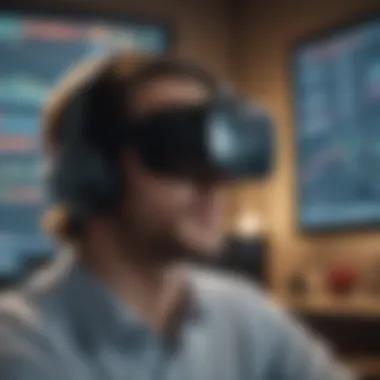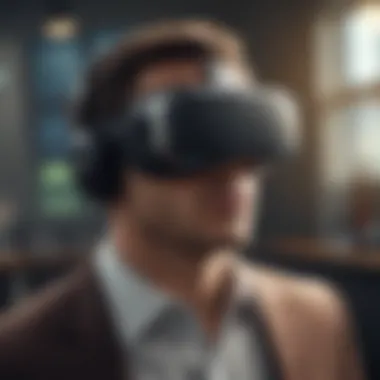Unleashing the Potential: The Future of VR in Stock Market Analysis


Market Analysis
Discussing the potential impact of Virtual Reality (VR) technology on stock market analysis requires a deep dive into current market trends. Traditional methods of data analysis are being challenged by the advent of VR, bringing a new dimension to how investors perceive and interpret market information. The seamless integration of VR tools can enhance data visualization capabilities and provide a more immersive experience for analyzing stock market dynamics.
Industry-specific Analysis
When applying VR technology to industry-specific analysis within the stock market, each sector presents unique opportunities and challenges. For instance, the healthcare sector may benefit from VR simulations for understanding complex biomedical data, while the technology sector could leverage VR for visualizing intricate tech trends. By delving into sector-specific applications of VR in stock market analysis, investors can gain valuable insights tailored to their areas of interest.
Market Volatility and Risk Factors
One of the key considerations in stock market analysis is market volatility and risk factors. VR technology can aid in creating dynamic simulations that mimic real-time market fluctuations, allowing investors to assess risk exposure and develop strategies to mitigate potential losses. By exploring the role of VR in simulating different market scenarios, analysts can better prepare for volatile market conditions and make informed investment decisions.
Introduction
Virtual Reality (VR) technology is poised to transform stock market analysis in unprecedented ways. This article delves into the disruptive potential of VR in revolutionizing the financial landscape. By enhancing data visualization and optimizing decision-making processes, VR presents novel opportunities for investors and analysts to gain deeper insights into market dynamics.
Understanding VR Technology
The Basics of VR
Virtual Reality technology involves creating immersive, computer-generated environments that simulate physical presence. This critical aspect of VR technology allows users to interact with digital spaces and objects in a lifelike manner, enhancing the overall user experience. The unique feature of VR lies in its ability to blur the line between the physical and digital realms, offering users a truly immersive and engaging experience in stock market analysis.
Applications in Various Industries
VR technology finds applications across various industries, from healthcare to education and entertainment. In the context of stock market analysis, VR can provide an interactive platform for visualizing complex market data. Its benefits include improved understanding of market trends and patterns, leading to informed investment decisions. However, challenges such as expensive hardware requirements and potential technological constraints need to be considered.
Significance of VR in Finance


Enhancing Data Visualization
Enhancing Data Visualization is a pivotal aspect of VR in finance. By leveraging VR technology, analysts can represent intricate financial data in visually compelling ways, enabling stakeholders to grasp complex information more effectively. The immersive nature of VR enhances data interpretation, facilitating quicker insights and better decision-making within the financial sector.
Improving Decision-making Processes
VR plays a crucial role in enhancing decision-making processes within the finance industry. Real-time market analysis and risk assessment mechanisms integrated into VR platforms empower investors to make proactive decisions based on accurate data. Despite its advantages, challenges such as data security concerns and ethical considerations require meticulous attention when implementing VR solutions in financial settings.
Purpose of the Article
Exploring VR Integration in Stock Market Analysis
Exploring VR Integration in Stock Market Analysis is central to this article's focus. By exploring how VR technology can revolutionize stock market analysis, this article aims to illuminate the potential benefits and challenges of integrating VR in financial decision-making processes. The unique feature of VR integration lies in its capacity to offer immersive data visualization tools and interactive trading environments, shaping the future of financial analysis.
Impact on Financial Decision-making
The Impact on Financial Decision-making is profound with the integration of VR technology. By providing analysts and investors with new tools for analyzing market trends and evaluating risks, VR integration has the potential to redefine traditional financial approaches. However, adapting to this technological shift requires a thorough understanding of VR's capabilities and limitations to harness its full potential in financial decision-making practices.
The Role of VR in Stock Market Analysis
In the intricate realm of stock market analysis, Virtual Reality (VR) emerges as a disruptive force, poised to reshape how data is visualized and decisions are made. VR technologies offer a fresh perspective on analyzing complex market dynamics, introducing interactive elements that elevate the traditional methods of financial analysis. By immersing users in simulated environments, VR revolutionizes the way stock market data is perceived and processed, paving the way for more informed investment strategies and precise decision-making processes.
Enhanced Data Visualization
Visualizing Complex Market Data
The essence of visualizing complex market data lies in its ability to dissect intricate financial information into comprehensible visuals. By transforming numbers and trends into immersive 3D representations, analysts and investors can grasp the nuances of market fluctuations with unprecedented clarity. The unique characteristic of visualizing complex market data lies in its potential to unveil hidden patterns and correlations, enabling stakeholders to make data-driven decisions effectively. While this approach presents advantages in enhancing analytical depth, it also demands a level of caution in interpretation to prevent misinformation or skewed perspectives.


Interactive Data Analysis
Interactive data analysis redefines the traditional methods of dissecting market trends by fostering dynamic engagement with financial data. Through VR interfaces that respond to user inputs, analysts can explore datasets in real-time, extract insights swiftly, and adjust variables to simulate different scenarios. The distinctive feature of interactive data analysis is its ability to promote agile decision-making through instant interaction with data points, facilitating a responsive approach to market changes. However, the reliance on user inputs introduces a level of subjectivity that necessitates careful calibration to ensure accurate interpretations.
Improved Decision-making Processes
Real-time Market Analysis
Real-time market analysis accentuates the importance of up-to-the-minute information in shaping financial decisions. By providing instantaneous updates on market performance, VR platforms equip users with the tools to react swiftly to emerging trends and capitalize on timely opportunities. The key characteristic of real-time market analysis is its ability to offer a competitive edge through proactive decision-making, enabling investors to stay ahead of market shifts. While the advantages of real-time analysis are evident in its responsiveness, potential disadvantages may arise from information overload and the need to differentiate between noise and valuable insights.
Risk Assessment and Management
Risk assessment and management through VR platforms introduce a proactive approach to identifying and mitigating potential financial risks. By simulating risk scenarios in dynamic virtual environments, analysts can evaluate the impact of different decisions on portfolios and develop robust risk management strategies. The unique feature of risk assessment and management lies in its capacity to nurture a culture of risk-awareness and preparedness among stakeholders, fostering a proactive stance towards uncertainties. Nonetheless, challenges in accurately modeling all risk factors and their interplay may pose limitations to the effectiveness of virtual risk assessments.
Virtual Trading Environments
Simulated Trading Scenarios
Simulated trading scenarios offer a sandbox for investors and analysts to test strategies and tactics in a risk-free virtual environment. By replicating market conditions and trends, VR platforms enable users to hone their trading skills, explore innovative approaches, and gauge the outcomes of different investment decisions. The key characteristic of simulated trading scenarios is their capacity to bridge theoretical knowledge with practical experience, instilling confidence and expertise in navigating volatile market conditions. However, the persuasive nature of simulated environments may create biases in decision-making that require awareness and mitigation strategies.
Training and Skill Development
Training and skill development modules within VR settings offer a structured pathway for novice investors to enhance their financial acumen and decision-making abilities. Through interactive tutorials, scenario-based simulations, and personalized feedback, users can refine their analytical skills, understand market mechanisms, and practice risk management strategies in a controlled virtual setting. The unique feature of training and skill development lies in its transformative potential to empower individuals with the knowledge and confidence to navigate the complexities of stock market analysis effectively. Despite the advantages of immersive learning experiences, challenges in translating virtual skills to real-world scenarios may necessitate ongoing practice and alignment with practical market dynamics.
Implementing VR in Financial Analysis
Virtual Reality (VR) is poised to transform the landscape of financial analysis by introducing new dimensions of immersive experiences. Implementing VR in financial analysis opens avenues for enhanced decision-making processes and enriched data visualization. This article delves deep into the critical importance of integrating VR technology into financial analysis, shedding light on the benefits and challenges this disruptive technology offers. By incorporating VR tools into financial analysis frameworks, professionals can explore complex market data in interactive ways, leading to refined strategies and more informed decisions.


Challenges and Opportunities
Integration with Existing Platforms
Integration with existing platforms is a cornerstone in the successful adaptation of VR in financial analysis. By seamlessly integrating VR tools with established financial systems, analysts can harness the power of immersive technology without disrupting existing workflows. This streamlined integration ensures a smoother transition towards a VR-driven financial analysis approach, enhancing efficiency and accuracy in decision-making processes.
Data Security Concerns
One of the primary considerations in implementing VR in financial analysis is navigating the intricate landscape of data security. Data security concerns regarding VR applications require meticulous attention to safeguard sensitive financial information. While VR technology offers unprecedented insight and visualization capabilities, mitigating potential vulnerabilities and ensuring data privacy remain paramount for sustainable integration.
Future Prospects
Potential for Market Disruption
The potential for market disruption through VR implementation in financial analysis signifies a paradigm shift in traditional investment strategies. By leveraging VR technology to analyze market trends and simulate investment scenarios, financial professionals can uncover hidden opportunities and navigate volatile market conditions with heightened precision. The disruptive nature of VR in financial analysis paves the way for innovative approaches to wealth management and sustainable growth strategies.
Innovations in VR Applications
Innovations in VR applications continuously shape the future of financial analysis, offering novel ways to interpret and interact with vast datasets. With advancements in VR technology, analysts can delve into virtual trading environments, refine their decision-making skills, and explore real-time market analysis in unprecedented detail. The distinctive feature of VR applications lies in their ability to merge advanced visualization techniques with intuitive interfaces, revolutionizing how financial data is processed and interpreted.
Conclusion
In this concluding section, we delve into the vital significance of the future of Virtual Reality (VR) in stock market analysis. Here, we reflect on the amalgamation of VR technology with financial analysis and its profound impact. Understanding the implications and possibilities that VR offers to investors and analysts is paramount in navigating the ever-evolving landscape of the stock market. The discussion will emphasize the transformative potential of VR in enhancing data visualization, revolutionizing decision-making processes, and creating immersive virtual trading environments tailored to improve trading strategies and skill development. Through a critical lens, we analyze the benefits, challenges, and the overall trajectory of integrating VR in financial analysis.
Key Takeaways
-#### Impact of VR on Stock Market Analysis VR's impact on stock market analysis is monumental, revolutionizing how market data is perceived and analyzed. The immersive nature of VR enables investors to visualize complex data in ways previously unattainable, offering a deeper understanding of market trends and patterns. This feature proves invaluable in making informed investment decisions and managing risks effectively. However, the adoption of VR may pose challenges related to data security and the need for specialized training.
-#### Adapting to Technological Advances Adapting to technological advances is crucial for staying ahead in the financial analysis landscape. Embracing VR integration signifies a proactive approach towards leveraging cutting-edge technology for market analysis. The ability to adapt and harness the power of VR tools sets the stage for enhanced decision-making processes and strategic investments, fostering a competitive edge in the market. While the benefits of technological advancement are evident, it is essential to balance innovation with traditional financial principles.
Final Thoughts
-#### Embracing Innovation in Financial Analysis Embracing innovation in financial analysis entails exploring new frontiers in data interpretation and decision-making. By incorporating VR technology, analysts can gain a nuanced perspective on market dynamics, leading to more accurate predictions and optimized investment strategies. Embracing innovation also fosters creativity in problem-solving within the financial sector, paving the way for groundbreaking advancements in stock market analysis.
-#### The Evolution of Stock Market Tools The evolution of stock market tools signifies a paradigm shift towards more sophisticated and efficient analytical methods. VR's integration represents a significant milestone in this evolution, offering unparalleled insights and a dynamic approach to assessing market performance. The versatility of VR tools allows for personalized experiences, enabling professionals to tailor their analytical processes to suit their specific needs. Despite its advantages, the evolution of stock market tools also warrants attention to potential limitations and the necessity of continuous adaptation to new technologies for sustained success.













